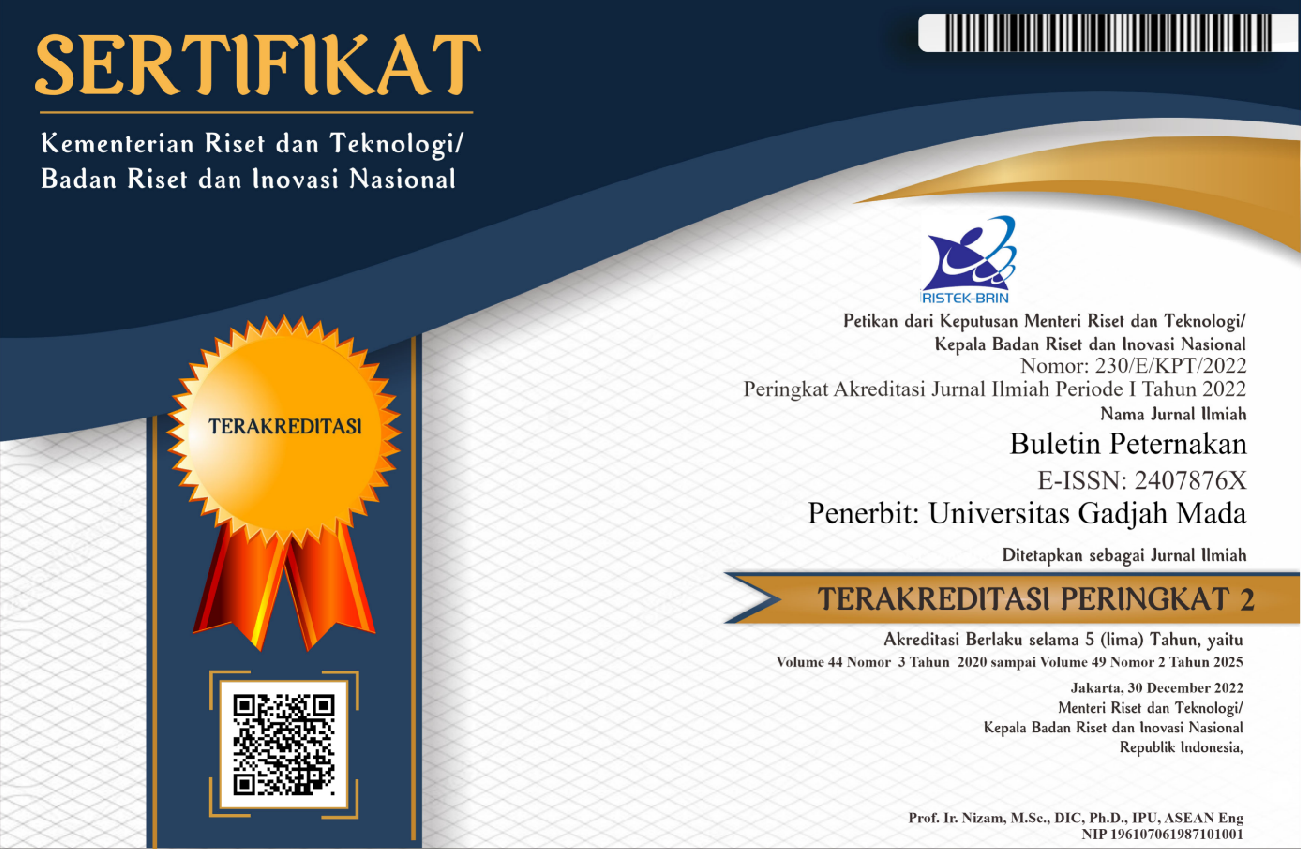Tolerance Level of Butterfly Pea (Clitoria ternatea L.) to Stress Acidity Through Tissue Culture Technique
Kennaya Putri Aura Jannah(1*), Panca Dewi Manu Hara Karti(2), Iwan Prihantoro(3)
(1) Department of Nutrition and Feed Technology, Faculty of Animal Science, Institut Pertanian Bogor, Bogor, 16689
(2) Department of Nutrition and Feed Technology, Faculty of Animal Science, Institut Pertanian Bogor, Bogor, 16689
(3) Department of Nutrition and Feed Technology, Faculty of Animal Science, Institut Pertanian Bogor, Bogor, 16689
(*) Corresponding Author
Abstract
Butterfly pea (Clitoria ternatea L.) a high-quality legume that is rich in protein and grows on various soil types with a pH range of 5.5-8.9. This experiment was conducted to get the level of tolerance of butterfly pea plants to stress acidity at different levels through tissue culture technique. The study was designed using a complete randomized design with 6 treatments with the different levels of AlCl3 addition using Murashige Skoog (MS) media with 20 replications (P0 (0 ppm AlCl3), P1 (100 ppm AlCl3), P2 (200 ppm AlCl3), P3 (300 ppm AlCl3), P4 (400 ppm AlCl3), and P5 (500 ppm AlCl3)). Data were analyzed using analysis of variance (ANOVA), and if there was a significant difference, data were further analyzed using Duncan’s multiple range test. The variables observed were acidity media changes, plant height gain, number of leaves, number of branches, number of tillers, percentage of leaves withering, and leaf color. The results showed that the butterfly pea plant has mechanism of adaptation to acid stress on the parameters of plant height gain and number of leaves at the end of the observation. However, the level of plant tolerance on the parameters of the number of branches and the number of tillers was ≤ 300 ppm (pH 3.73).
Keywords
Full Text:
6. Aura JannahReferences
Blum, A. 1996. Crop responses to drought and the interpretation of adaptation. Plant Growth Regulation. 20: 135-148.
Cook, B. G., B. C. Pengelly, S. D. Brown, J. L. Donnelly, D. A. Eagles, M. A. Franco, J. Hanson, B. F. Mullen, I. J. Partridge, and M. Peters. 2005. Tropical Forages. CSIRO. Brisbane.
Damayanti, F., Suharsono, I. Marika, and A. Tjahjoleksono. 2017. Agrobacterium tumefaciens-mediated transformation of MmCuZn-SOD gene to sugarcane (Saccharum officinarum CV. PS864) for acidic soil stress tolerance. International Journal of Agriculture and Biology. 19: 1489-1496.
Fahrunsyah. A.T. Batubara, R. Jannah, and A. A. Utama. 2023. Perubahan pH, aluminium dapat tukar dan fosfor tersedia ultisol karena pemberian pupuk organik batang pisang. Jurnal Agroekoteknologi Tropika. 6: 1-6.
Firmansyah, I. and N. Sumami. 2013. Pengaruh dosis pupuk N dan varietas terhadap pH tanah, N-total tanah, serapan N, dan hasil umbi bawang merah (Allium ascalonicum L.) pada tanah entisols-brebes jawa tengah. Jurnal Hortikultura. 23: 358-364.
Hue, V., G. R. Cradock, and F. Adams. 1986. Effect of organic acids on alumunium toxicity in subsoil. SSSAJ. 50:28-34.
Karamina, H., W. Fikrinda, and A. T. Murti. 2017. Kompleksitas pengaruh temperatur dan kelembaban tanah terhadap nilai pH tanah di perkebunan jambu biji varietas kristal (Psidium guajava L.). Jurnal Kultivasi. 16: 430-434.
Kasno, A. 2020. Perbaikan tanah untuk meningkatkan efektivitas dan efisiensi pemupukan berimbang dan produktivitas lahan kering masam.Jurnal Sumberdaya Lahan. 13: 27-40.
Kochian, L. V., M. A. Pineros, J. Liu, and J. V. Magalhaes. 2015. Plant adaptation to acid soils: the molecular basis for crop alumunium resistance. Annual Review of Plant Biology. 66: 571-598.
Kosai, P., K. Sirisidthi, and W. Jiraungkoorsku. 2015. Review on ethnomedical uses of memory boosting herb, Butterfly Pea, Clitoria ternatea. J. Nat. Remedies. 15: 71- 76.
Mulyani A. and M. Sarwani. 2013. Karakteristik dan potensi lahan sub optimal untuk pengembangan pertanian di Indonesia. Jurnal Pengelolaan Sumber daya Alam dan Lingkungan. 7: 46-57.
Prayitno, R. S., F. Wahyono, and E. Pangestu. 2018. Pengaruh suplementasi sumber protein hijauan leguminosa terhadap produksi amonia dan protein total ruminal secara. Jurnal Peternakan Indonesia. 20: 116–123.
Putra, I. A., dan H. Hanum. 2018. Kajian antagonism hara K, Ca, dan Mg pada tanah inceptisol yang diaplikasikan pupuk kandang, dolomit, dan pupul KCl terhadap pertumbuhan jagung manis (Zea mays saccharata L.). Journal of Islamic Science Technology. 14: 23-44.
Santosa, H. R., C. Suherman, and S. Rosniawaty. 2016. Respons pertumbuhan tanaman kopi robusta (Coffea robusta L.) tercekam aluminium di lahan reklamasi bekas tambang batubara bervegetasi sengon (Periode El Nino). Jurnal Agrikultura. 27: 124-131.
Septiani, N. M. N., Mukarlina, and E. R. P. Wardoyo. 2017.Pertumbuhan dan Karakter Anatomi Mimosa Air (Neptunia oleracea Lour.) pada Air yang Terpapar Logam Aluminium (Al). Jurnal Protobiont .2017. 6 : 75 – 82.
Silva, C. O., D. S. Brito, and A. A. Silva. 2020. Differential accumulation of aluminum in root tips of soybean seedlings. Brazillian Journal of Botany. 43: 99-107.
Sutedi, E. 2013. Potensi kembang telang (Clitoria ternatea) sebagai tanaman pakan ternak, Wartazoa. 23: 51-62.
Zaeni, A., S. Ambardini, A. Sartinah, A. N. Ramadhani, Sartini, A. Amin, G. W. Patiung, and P. E. Susilowati. 2021. Bioakumulasi logam crom (Cr), Seng (Zn) dan Nikel (Ni) pada tanaman obat binahong (Anredera cordifolia (Ten). Steenis. Akta kimindo 6: 12-28.
Ziraluo, Y. P. B. 2021. Metode perbanyakan tanaman ubi jalar ungu (Ipomea batatas poiret) dengan teknik kultur jaringan atau stek planlet. Jurnal Inovasi Penelitian 2: 1037-1046. Zulputra, Wawan, and Nelvia. 2014. Respon padi gogo (Oryza sativa L.) terhadap pemberian silikat dan pupuk fosfat pada tanah ultisol. Jurnal Agroekoteknologi Tropika. 4: 1-10
Article Metrics
Refbacks
- There are currently no refbacks.

This work is licensed under a Creative Commons Attribution-ShareAlike 4.0 International License.
Buletin Peternakan (Bulletin of Animal Science) Indexed by:

This work is licensed under a Creative Commons Attribution-ShareAlike 4.0 International License.









